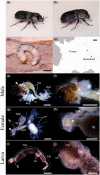The presence of a mycangium in European Sinodendron cylindricum (Coleoptera: Lucanidae) and the associated yeast symbionts
- PMID: 27432353
- PMCID: PMC4948600
- DOI: 10.1093/jisesa/iew054
The presence of a mycangium in European Sinodendron cylindricum (Coleoptera: Lucanidae) and the associated yeast symbionts
Abstract
Part of the exoskeleton of some wood-inhabiting insects is modified to form a mycangium, which is a specialized organ used to convey fungal spores or yeasts to their offspring. Although most stag beetles (Coleoptera: Lucanidae) are known to have female-specific mycangia and associated yeast symbionts, the evolutionary origin of the mycangium in this group remains unresolved. Here, we report the presence of a mycangium and associated yeast symbionts in the European horned stag beetle Sinodendron cylindricum (L.), which belongs to an ancestral clade of the Lucanidae. The mycangium of S. cylindricum is shown to be female-specific and have the same developmental origin as that of other stag beetles. A total of five yeast strains were isolated from adult mycangia and larval gut of S. cylindricum Of these, we suggest that SICYAM1 is an undescribed yeast with taxonomic novelty, and have identified SICYLG3 as the xylose-fermenting yeast Scheffersomyces insectosa using nuclear ribosomal RNA and ITS sequences. The remaining three yeast strains, SICYAM2, SICYLG1, and SICYLG2, were assigned to the genus Sugiyamaella Yeast density in the adult mycangium was lower than that of the more evolutionarily advanced stag beetles, the European Lucanus cervus (L.) and Dorcus parallelipipedus (L.), which were also examined in this study. No living yeasts were isolated from the adult guts. However, a third instar larva of S. cylindricum harbored 10(4)-10(6) living yeasts in each gut region, which suggests that gut yeasts play an important role in these wood-feeding larvae.
Keywords: evolution; gut flora; insect–fungal associations; saproxylic insects; vertical transmission.
© The Authors 2016. Published by Oxford University Press on behalf of Entomological Society of America.
Figures



Similar articles
-
Symbiotic yeasts from the mycangium, larval gut and woody substrate of an African stag beetle Xiphodontus antilope (Coleoptera: Lucanidae).Antonie Van Leeuwenhoek. 2020 Aug;113(8):1123-1134. doi: 10.1007/s10482-020-01418-1. Epub 2020 Apr 21. Antonie Van Leeuwenhoek. 2020. PMID: 32318983
-
Specificity and genetic diversity of xylose-fermenting Scheffersomyces yeasts associated with small blue stag beetles of the genus Platycerus in East Asia.Mycologia. 2017 Jul-Aug;109(4):630-642. doi: 10.1080/00275514.2017.1382648. Epub 2017 Nov 15. Mycologia. 2017. PMID: 29140770
-
Discovery of mycangia and the associated xylose-fermenting yeasts in stag beetles (Coleoptera: Lucanidae).Naturwissenschaften. 2010 Mar;97(3):311-7. doi: 10.1007/s00114-009-0643-5. Epub 2010 Jan 27. Naturwissenschaften. 2010. PMID: 20107974
-
Mycetocyte symbiosis in insects.Biol Rev Camb Philos Soc. 1989 Nov;64(4):409-34. doi: 10.1111/j.1469-185x.1989.tb00682.x. Biol Rev Camb Philos Soc. 1989. PMID: 2696562 Review.
-
The ecology of yeasts in the bark beetle holobiont: a century of research revisited.Microb Ecol. 2015 May;69(4):723-32. doi: 10.1007/s00248-014-0479-1. Epub 2014 Aug 13. Microb Ecol. 2015. PMID: 25117532 Review.
Cited by
-
Evolutionary Relationship Between Platycerus Stag Beetles and Their Mycangium-Associated Yeast Symbionts.Front Microbiol. 2020 Jun 30;11:1436. doi: 10.3389/fmicb.2020.01436. eCollection 2020. Front Microbiol. 2020. PMID: 32695086 Free PMC article.
-
Presence of non-symbiotic yeasts in a symbiont-transferring organ of a stag beetle that lacks yeast symbionts found in other stag beetles.Sci Rep. 2023 Mar 14;13(1):3726. doi: 10.1038/s41598-023-30607-x. Sci Rep. 2023. PMID: 36918653 Free PMC article.
-
Expanding the geographical distribution of Blastobotrysmalaysiensis (Saccharomycetales) beyond the Asian continent - a cave fungus first reported in the Americas.Biodivers Data J. 2022 Nov 15;10:e80226. doi: 10.3897/BDJ.10.e80226. eCollection 2022. Biodivers Data J. 2022. PMID: 36761671 Free PMC article.
-
Saccharomyces cerevisiae - Insects Association: Impacts, Biogeography, and Extent.Front Microbiol. 2020 Jul 14;11:1629. doi: 10.3389/fmicb.2020.01629. eCollection 2020. Front Microbiol. 2020. PMID: 32760380 Free PMC article. Review.
-
Lateral Transmission of Yeast Symbionts Among Lucanid Beetle Taxa.Front Microbiol. 2021 Dec 14;12:794904. doi: 10.3389/fmicb.2021.794904. eCollection 2021. Front Microbiol. 2021. PMID: 34970248 Free PMC article.
References
-
- Alexander K. N. A. 2002. The invertebrates of living and decaying timber in Britain and Ireland. Engl. Nat. Res. Rep. 467: 9–142.
-
- Araya K. 1993. Relationship between the decay types of dead wood and occurrence of lucanid beetles (Coleoptera: Lucanidae). Appl. Entomol. Zool. 28: 27–33.
-
- Araya K. 2002. Effects of variation in dead wood on resource utilization patterns and fitness of lucanid beetles (Insecta, Coleoptera, Lucanidae). Jpn. J. Ecol. 52: 89–98.
-
- Arrow G. J. 2005. Horned beetles: a study of the fantastic in nature. Natural History Publications (Borneo) Sdn. Bhd, Kota Kinabalu.
MeSH terms
Substances
LinkOut - more resources
Full Text Sources
Other Literature Sources
Research Materials

